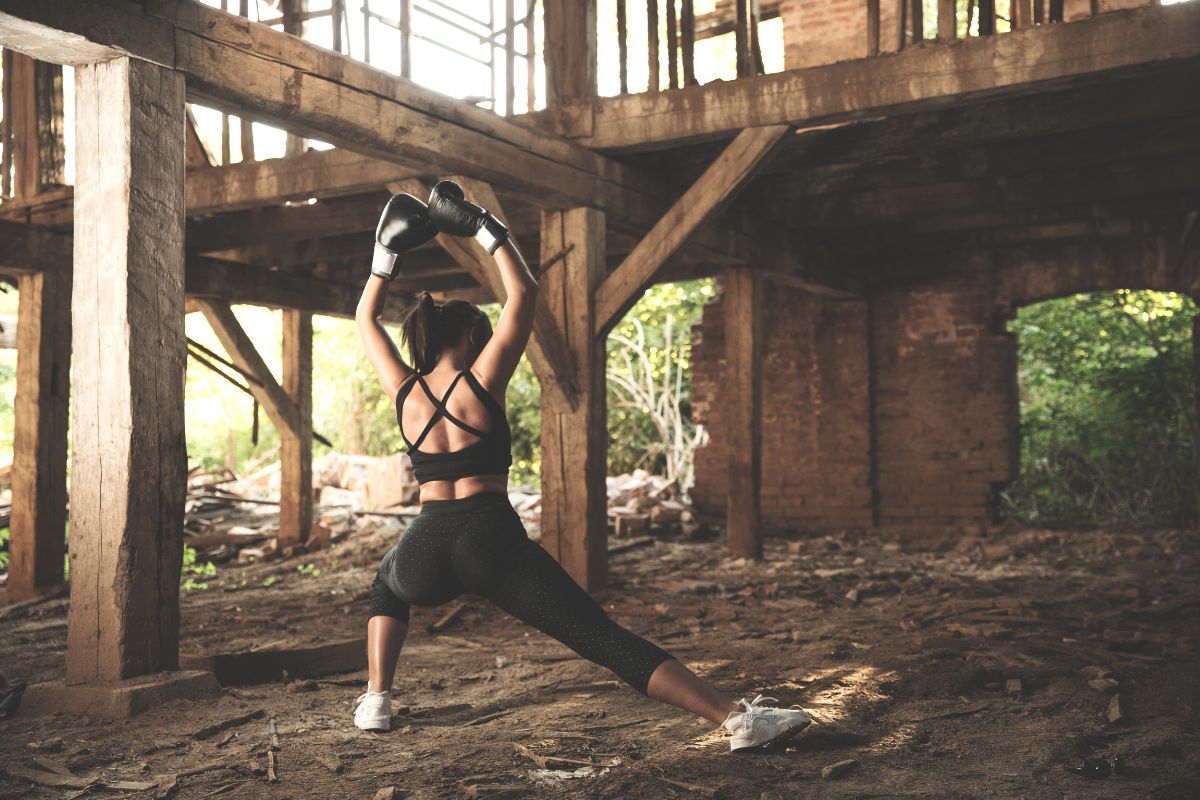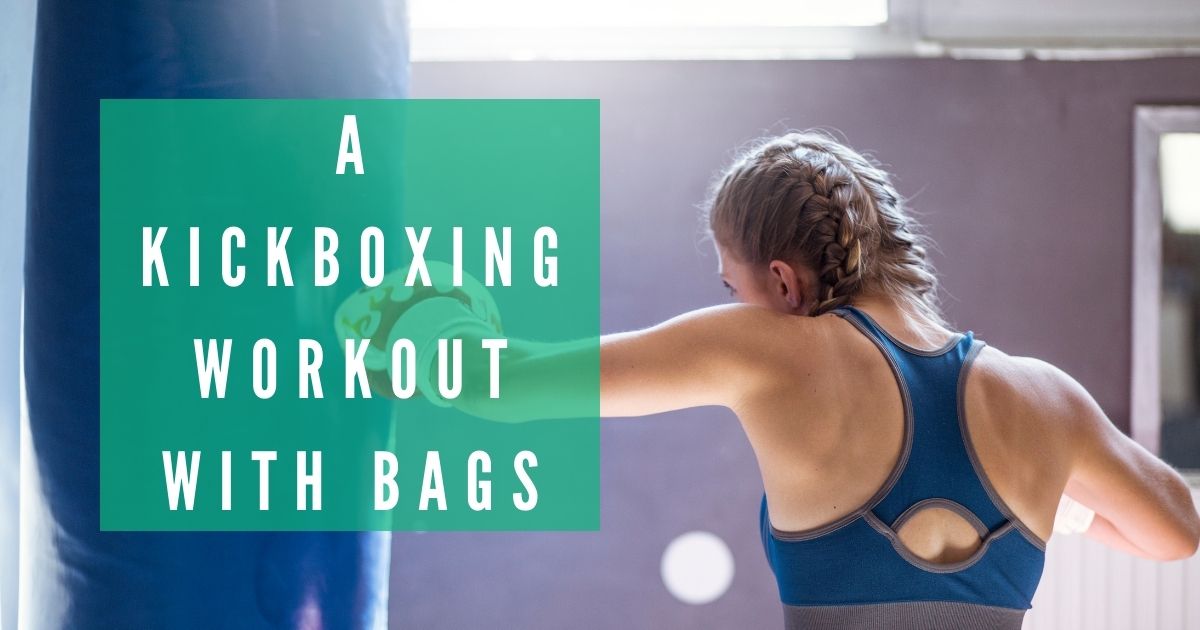What is Kickboxing?
Is it too hard to throw a few jabs at the punching bag? If you have done the kickboxing workout with a bag, you understand that it is a worthwhile challenge.
Most heavy punching bags weigh between 50 pounds (22.68 kilograms) and 150 pounds (68.04 kilograms). Consequently, each time you lay into the bag, your foot, fist, or knee will encounter considerable resistance.
The first impact will be somewhat grating, and it will not take long to realize you cannot escape by throwing soft punches. It requires that you engage your whole body, including shoulders, core, and hips. This approach will help you control your movements when hitting the bag.
Moreover, the exercise that engages your whole body will also help you burn some calories and strengthen your main muscle groups. Additionally, a cardio kickboxing workout is a cardiovascular exercise that offers you upper body and bone-building rhythmic impact.
In this guide, you will learn more about kickboxing workouts with bags. It would help to perform each exercise following the suggested time intervals. Moreover, take a one-minute rest after finishing the training and repeat it a second time.

How to Punch a Punching Bag
Punching bags are an excellent way to stay fit, build up strength and lessen anxiety. First, however, you need to find the right bag for your boxing bag training needs and stick to the proper technique. Then, you only need some preparation, technique, and plenty of hard work, and you will be punching the bag like a pro.
Below are some valuable tips you can apply when punching a punching bag:
Warm-Up
Start with an excellent warm-up to reduce the risk of injury. You will discover more about this later in this article.
Start Slow
Punching bags will help you build and grow your striking power which takes time. Therefore, you should take your time in the beginning. For example, you can start by punching the kickboxing bag for 30 seconds and increasing it by 30 seconds for each new session.
When performing intense striking sessions, they should not last longer than 5 minutes. Moreover, perform at most four sessions in a week. Please don’t overpower your punches and kicks, as you can risk injury.
Experts suggest you should treat a heavy bag workout like an actual fight. This means that you don’t go all-out at first; otherwise, this will wear you out after less than 20 seconds. Instead, gradually work your way in throwing slower punches, then slowly introduce power and speed.
Smack Correctly
When you punch the bag, ensure your index and middle fingers’ knuckles hit the punch bag first. When you strike with the smaller knuckles, you increase your break chances. Of course, you should have kickboxing gloves to make it feel like an actual fight.
Balance is Critical
Balance and posture are critical when it comes to freestanding punch bag training. Therefore, it would be best if you only introduced speed and force after you have attained an appropriate punching rhythm with proper balance and excellent posture. For example, as you throw punches at the punching bag, avoid throwing yourself or falling into the bag.
Instead, maintain your balance when punching by keeping your feet rooted on the floor. Experts advise that your whole body remains aligned throughout the workout when focusing on balance and good posture. As a result, you burn more calories, reduce injury risk, and get better exercise.
Use the Right Wrist and Elbow Technique
During your punching bag exercise, you should keep your wrists straight and your elbows tight. For example, as you hot the punchbag with your fists, ensure you keep your wrists straight; otherwise, you risk getting a strain and sprain injury. Therefore, ensure your elbows are tight when punching without tensing them.
Use Swift Punches
This may sound obvious, but you could quickly start pushing the bag around using your fists instead of hitting it with swift punches. It also happens a lot when you begin to tire. If your bag produces a sharp smack sound instead of a thud, then you have gotten your technique right.
Move
It is also advisable to keep moving whenever you are not punching. You need to be on the defense whenever you are not hitting in a real kickboxing fight. These rules are also applicable in your punchbag exercises. Therefore, ensure your feet, hands, and head move between punches.
Another important secret is to avoid hesitation. When you watch professional kickboxers, they don’t take over two seconds between punches. Therefore, don’t wait to throw your punches.
Have the Proper Breathing Techniques
As you throw the punches, focus on breathing rhythmically. For example, if you are moving fast, breathe fast. Experts advise that breathing while punching is more critical than punching. Moreover, proper breathing helps conserve your strength and develop your intensity with time.
One common mistake you could make is to hold your breath while punching. Instead, please exhale each time you strike.
Kicking Form
It would help to practice a good kick form. For example, avoid striking the bag with your toes or ankle. Instead, ensure you hit the sack with your instep or the side of your foot, adhering to proper techniques. Also, ensure you have your kickboxing shin guards on when performing your kickboxing workout.
After developing technique and stamina, try working your punchbag with punching and kicking combinations.
Muay Thai vs. Kickboxing – The Difference
Many people assume that Muay Thai and kickboxing are similar. However, they are quite different in various facets, such as the fighters’ fighting styles and techniques. While there are some universal techniques that the two sports share, the fighters usually implement the techniques differently.
Their definitions also help to explain the difference between the two. For example, Muay Thai boxing is a term that describes a combat sport whose origin is Thailand. The sport is also known as Thai kickboxing. The sport utilizes stand-up striking together with several other clinching techniques.
Therefore, Muay Thai can generally fit under kickboxing, but their differences are more than similarities. Here are the most notable differences between the two:
The main difference between the two is that kickboxing is a four-point striking system that includes kicks and punches only. On the other hand, Muay Thai is an eight-point striking system that involves the fighter applying kicks, punches, elbows and knees, and whole upper body wrestling.
Therefore, when you go to a Muay Thai school, the fighters learn to remain patient until they get the chance to strike. This is when they move forward assertively. On many occasions, the openings come immediately after an opponent strikes.
As a result, counterattacks are a vital ingredient of Muay Thai. Moreover, there is also limited head movement, circling, and weaving present in kickboxing.
Kickboxing mainly utilizes hands, angles and movements, and volume combos. On the flip side, Muay Thai is primarily a timed sport that relies heavily on quick and potent counterattacks.
Kickboxers use several combos, while Muay Thai fighters favor a timed weapon. As a result, the movements of kickboxers tend to be more defensive and fluid when you compare them to the actions by Muay Thai fighters.
This means that kickboxers employ angles and footwork more when setting up their attacks. As a result, they don’t rely on well-coordinated and forceful forward movement and counterattacks Muay Thai fighters use.
However, it does not mean that Muay Thai fighters don’t use fluid footwork completely. It is just more prominent in kickboxing.
Additionally, Muay Thai fighters execute their techniques differently from kickboxing. For instance, Muay Thai fighters kick by turning the hip and linking it with the shinbone. On the other hand, several types of kickboxing involve snapping the knee to throw a kick, and you connect them to the foot.
Additionally, there is a difference when delivering kicks in the two sports regarding where the fighter can hit their opponent. For example, Muay Thai allows its fighters to use shin kicks and strikes below the waist area. However, it prohibits them from striking their opponent’s groin area for sportsmanship’s sake.
On the flip side, kickboxing allows its fighters to employ a wide range of kicks. For example, they can use their feet lower and mid-shin. However, in general, a kickboxing fighter cannot kick their opponents below the waist.

A Kickboxing Warm-Up Exercise
Before starting your kickboxing exercise, it is essential to warm up for around five to ten minutes. An excellent warm-up entails activities that imitate the movements you will use in your actual workout.
Perform each of the moves below for 30 seconds. Complete the series three to four times.
- Jog on the spot.
- Perform jumping jacks.
- Air squats.
- Perform light punches into the air (shadowboxing). Alternate the arms bouncing lightly from one foot to the other like a boxer.
- Perform high planks to downward dogs. Begin from a pushup position and press your hips up toward the ceiling, extending your shoulders and reaching your heels toward the ground to come to a downward dog. Then, go back to a high plank position and continue. Alternate between the two.
Jabbing, Crossing, and Squatting
This workout talks 45 seconds of work and 15 seconds of rest. Begin in a boxing stance position facing the punching bag. Keep your feet shoulder-width apart and one in front of the other.
When you look at your feet, the toes of the foot in front should be in the same line as the heel of your other foot. Moreover, the toes of the two feet should point at a 45-degree angle to the punching bag.
Lift your hands and position them as though you were ready to punch. Keep in mind that one of your arms should protect your face.
Hurl two blows in quick progression – begin with a left jab, then cross with your right before you perform a crouch. Instantly, go back to the standing position and keep serving the jab-cross-squat sequence for the entire 45 seconds.
After the 45 seconds are up, take a 15-minute rest, then immediately proceed to the next exercise.
Dominant and Non-Dominant Cross Punches
This exercise also lasts 45 seconds for each arm with a 15-seconds break.
The cross punches target your shoulders and arms. Kickboxing workouts trainers advise that you should ensure you are genuinely hurling your full force into every cross punch. Moreover, keep your abs tight and protect your face using your non-working hand.
The secret behind this technique is that the cross’s power comes from transmitting your weight onward as you perform your swing.
For example, if you are right-handed, take a boxing posture – put your left foot forward and your weight mainly on your back foot. This position shifts your center of gravity slightly away from the punching bag. Left-handed individuals should set up in reverse.
While taking the punch across your body using your dominant arm and shifting your weight forward, use your weight’s force to propel your fist to the bag. After completing the punch, ensure you return your hand to its place in front of your face. Please don’t swing it down!
Moreover, shift your weight back to the start position to prepare for the next powerful cross. Keep going for the entire 45 minutes using your main arm. Then, take a 15-minute break before moving on to the following kickboxing workout at home.
After that, shift to the non-dominant arm. Then, follow the instructions above using your non-dominant arm to perform the cross punches.
Kickboxing Side-Kick Punch Combos
This kickboxing exercise lasts 90 seconds with a 30 seconds rest.
Set your timer for 90 seconds and perform as many repetitions as possible. This series has four moves as outlined below:
- Ten reps of your right side-kicks.
- 30 straight punches.
- Ten reps of left side-kicks.
- 30 straight punches.
Start by standing a leg’s length away from your punching bag so that your right side is facing the sack. Then, get into your boxing position with your right leg back. Put your arms up with the left arm guarding your face and your right hand in front of your chin.
Rotate your hips as you shift your weight to the left foot before pivoting. At the same time, lift your right leg from the ground with your knee bowed.
Forcefully smack your right foot out, extending your knee and hip as you hit the punching bag with your right foot’s heel. It would help to flex your right foot and stick the heel out to make contact with the punching bag.
Recoil your foot and knee instantaneously and bring it back to the starting posture. Perform ten kicks on the right side. Then, perform 30 straight punches to the bag using your right arm. Switch position so that your left side faces the punching bag and continues.
Deliver ten left-side kicks, then 30 straight punches after that. Perform as many rounds as you can within 90 seconds.
Cross, Lunge, Kick, and Jab Exercises
Stand a leg’s-length from the punching bad facing it. Step toward the back with your right foot to execute a reverse lunge. Then, from the lunge’s bottom, powerfully explode up, transferring your weight to your left foot as you go back to the standing position.
In the process, swing your right knee up in front of your body, performing a solid front kick extending your right heel into the punching bag. After that, return the right foot down into a boxing posture staggering your feet before performing four cross punches.
Keep alternating sides until the 45 seconds is over. Then, rest for 15 seconds before proceeding to the next beginner kickboxing workout with a bag.
Dominant and Non-Dominant Kickboxing Hooks
You will perform hooks for 45 seconds on each side, taking a 15-second break in between.
This is an unbelievable learning workout you will find in kickboxing classes. The hook punches demand swift, powerful cross-body movements that fire up your hips, shoulders, and core.
Begin from a boxing posture staggering your dominant foot back. Turn your front foot around 45 degrees, centering your weight between your legs. Elevate your back heel from the ground and raise your hands to your face.
Perform consecutive hook punches using your dominant hand. The ideal way to do this would be to twist your back hip forward, pivoting on your back foot. Then, use your core strength to swing your dominant hand up and across your body, punching the bag at an angle so that your forearm ends up parallel to the floor before your face.
Turn to the starting posture and keep going as fast and powerfully as possible for the entire 45 seconds. Then, rest for 15 seconds and repeat the same movement on the other side.
Kickboxing Burpees, Pushups, and Straight Hooks
This is the last exercise in this series before getting the rest you deserve, so push hard and finish strong.
Begin by standing an arm’s length from the punching bag. Keep your feet hip-distance apart, bending your knees a little. Perform a burpee:
- Squat: place your hands flat on the floor below your shoulders. Step or jump your feet back, allowing your body to be in a high-plank posture keeping your core tight. Your body should form a straight line from the head to the heels.
- Perform a pushup by bending your elbows and lowering your chest toward the floor before pressing back to the high-plank posture.
- After that, jump or step your feet back, moving towards your hands.
- Burst upward as you jump into the air.
- Land gently and bend your knees and hips a bit.
After landing with your feet somewhat staggered in a boxing posture, punch the heavy bad immediately with a straight punch. Begin with the left right-hand straight punches, then perform left and right hook. Continue the exercise series for 45 seconds.
Our Bonus Kickboxing Workouts
Was the kickboxing workout at home with a bag too much for you? Attempt this bonus workout. This straightforward exercise alternates between pushups and punching. It also employs a reverse pyramid-style rep as outlined below:
- Ten pushups
- Ten punches
- Nine pushups
- Nine punches
- Eight pushups
- Eight punches
Continue the series by deducting one repetition from the previous number until you finish with one pushup and one punch. The great thing about this exercise is that it is substantially flexible. For example, you can replace pushups with lunges or squats.
Moreover, you keep the routine going by making your way up the pyramid, this time adding a repetition to each exercise. If you can perform up to five minutes of this workout exercise, it will be a perfect high-intensity finisher for your routine.

The Final Punch
Kickboxing Fitness training is excellent for professional fighters and individuals who want to stay fit. Moreover, you can train kickboxing for beginners to help you with self-defense. Fortunately, all the exercises are straightforward and allow you to start slowly and grow.
If you are a lady, don’t despair, there is women’s kickboxing for professional and personal use. Therefore, there is no excuse for not staying fit! Start your kickboxing workout with a bag for a healthier life!

